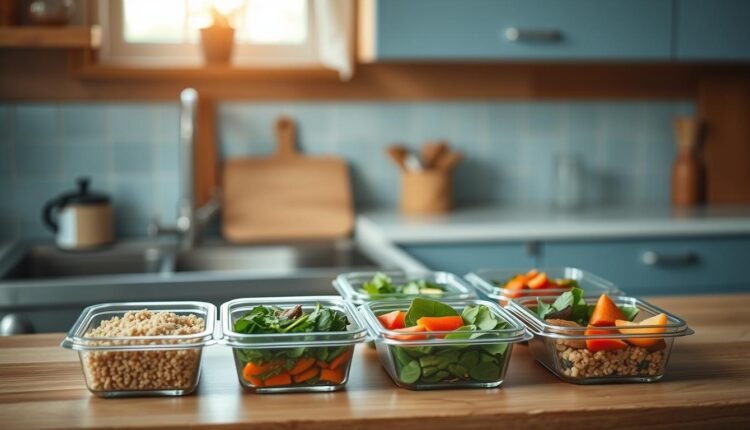Meal Prep For Work Lunches Without Kitchen Access
Discover simple meal prep for work lunches without kitchen access. Get practical tips and strategies for healthy, no-stress meals on-the-go.
I once prepped chicken wraps in a hotel bathroom using a coffee maker and mini-fridge. Let’s just say necessity sparks creativity. Whether you’re juggling a tiny office microwave or relying on shelf-stable ingredients, nourishing midday options are possible without a full kitchen.
This guide isn’t about Instagram-worthy bento boxes. It’s real solutions for real life: batch-prepped salads that stay crisp, protein-packed jars ready to shake, and freezer-friendly favorites that thaw by noon. You’ll discover how to turn limited tools into opportunities—like using a rice cooker for three different dishes.
Quick Takeaways:
- Efficient systems beat fancy appliances every time
- 17 practical sections help you navigate from planning to packing
Through trial and error (and many soggy sandwiches), I’ve learned that successful food prep thrives on flexibility. Let’s build your no-stress lunch rhythm together—one mason jar and strategic grocery haul at a time.
The Challenge of No Kitchen Access
Ever tried assembling a salad on your desk between meetings? I’ve watched cherry tomatoes roll into keyboard crevices more times than I’d like to admit. Office environments often force us to get creative—like using coffee mugs as measuring cups or repurposing file organizers as spice racks.
Limited Resources in the Office Environment
Most break rooms offer three tools: a microwave that beeps incessantly, a half-functional toaster, and a fridge that smells vaguely of last week’s fish. This reality shapes what you can realistically make. I learned this the hard way when my ambitious quinoa bowl turned into a cold, clumpy mess because the office microwave queue was 15 people deep.
Navigating Storage and Equipment Constraints
Smart planning starts with ingredients that travel well. Opt for sturdy vegetables like bell peppers or snap peas that won’t wilt in your bag. Use stackable containers to claim minimal fridge real estate—I’ve found square glass ones fit better than round plastic tubs. One client swears by her “office pantry”: shelf-stable items like individual olive oil packets and spice blends stored in a desk drawer.
Your best strategy? Treat Monday mornings like a tactical mission. Pre-portion dressings in tiny jars, pack pre-washed greens, and choose proteins that taste good cold. A little Sunday planning turns your cubicle into a functional prep space—no actual kitchen required.
Benefits of Meal Prep for Work Lunches
Picture this: It’s 8:15 AM, and you’re scrambling to find lunch options before rushing out the door. Been there? Structured planning turns chaos into calm. When you design your midday fuel in advance, you’re not just saving minutes—you’re reclaiming mental bandwidth.
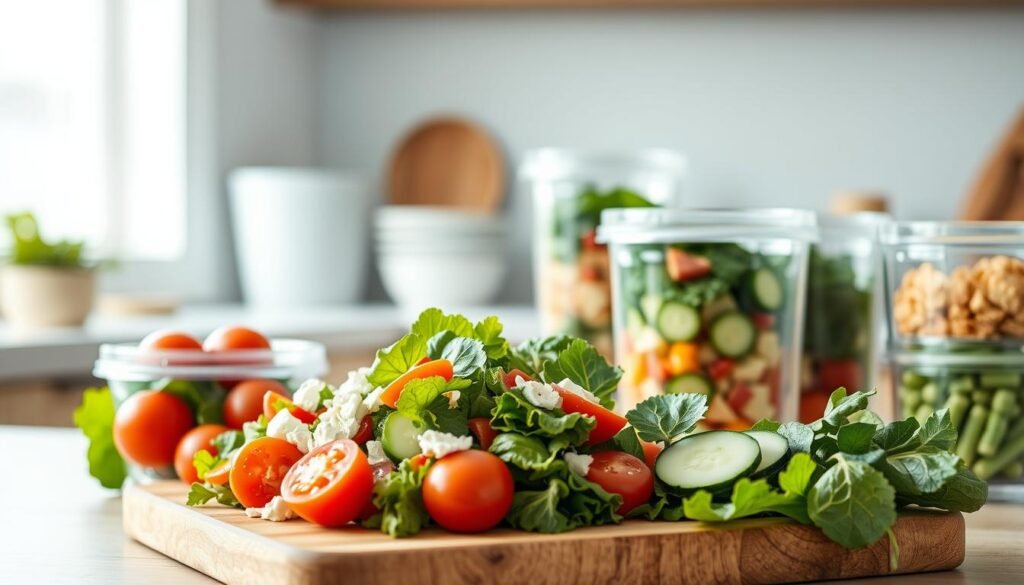
Mastering the Clock
Sunday batch cooking slashes weekday decision fatigue. One client reduced her morning routine from 45 minutes to 10 by:
- Roasting three sheet pans of veggies while prepping Monday’s emails
- Portioning Greek yogurt cups with frozen berries for grab-and-go snacks
- Storing pre-cooked grains in single-serving jars
“My ‘lunch locker’ system changed everything—I spend Sundays building five ready-to-assemble bases, then customize daily.”
Nutrition You Can Trust
Pre-planned lunches prevent vending machine emergencies. Compare typical choices:
| Fast Food | Prepped Option | |
|---|---|---|
| Calories | 920 | 480 |
| Prep Time | 15 min drive | 2 min assembly |
| Cost | $12 | $3.75 |
Crunchy salads with hardy bases like kale or shredded Brussels sprouts stay fresh for days. Pair them with portable proteins—think canned sardines or boiled eggs—for balanced energy that outlasts afternoon slumps.
Quick Tips for Meal Prep for Work Lunches
Thursday’s 10 AM hunger pang taught me more about planning than any cookbook. Smart midday fuel starts with systems, not grand gestures. Let’s transform chaotic mornings into smooth operations with strategies that fit real life.
Planning Ahead for Busy Days
Sunday nights determine Wednesday’s success. Keep these essentials in rotation:
- Boil six eggs while folding laundry—they’ll last three days
- Store pre-chopped veggies in water-filled jars to maintain crunch
- Freeze smoothie ingredients in dated bags for grab-and-blend mornings
One project manager told me: “I spend 15 minutes nightly building next day’s lunch—like assembling salad layers in jars. It’s faster than waiting in coffee lines.”
Choosing Portable and Versatile Recipes
Your best options work in multiple combinations. Try these no-fuss bases:
| Base Ingredient | Prep Time | Uses |
|---|---|---|
| Quinoa | 12 minutes | Salads, stir-fries, breakfast bowls |
| Roasted chickpeas | 25 minutes | Snacks, salad toppers, wrap fillings |
| Greek yogurt | 0 minutes | Dips, parfaits, savory sauces |
Rotate three core recipes weekly to prevent boredom. Last night’s roasted veggies become today’s wrap filling or tomorrow’s grain bowl mix-in. A five-minute evening investment saves 20 frantic morning minutes—that’s 100 reclaimed weekly minutes for coffee sipping or podcast listening.
Incorporating Fresh Salads and Bowls
Rainbow-colored veggies transformed my desk lunches from sad to vibrant. Crunchy textures and bold flavors turn ordinary midday breaks into sensory experiences. The secret? Treating salads as flavor canvases rather than afterthoughts.

Mediterranean Quinoa Salad Inspirations
My go-to base combines cooked quinoa with cherry tomatoes, diced cucumbers, and briny kalamata olives. Feta cheese adds creamy contrast—try crumbling it just before eating to maintain texture. This salad recipe thrives on balance: tangy lemon dressing cuts through rich ingredients while fresh parsley brightens every bite.
Creative Salad Recipe Variations
Rotate these mix-ins weekly to keep your bowl exciting:
| Add-In | Texture Boost | Flavor Pairing |
|---|---|---|
| Roasted chickpeas | Crispy | Cumin + paprika |
| Marinated artichokes | Tender | Garlic + oregano |
| Toasted pine nuts | Crunchy | Lemon zest + mint |
For pasta salad twists, swap mayo-based dressings with Greek yogurt blended with pesto. Fold in sun-dried tomatoes and grilled chicken for protein power. One reader shared: “I prep components separately—grains Sunday, veggies nightly—then assemble at my desk. Freshness lasts all week!”
Remember: sturdy vegetables like shredded kale hold up better than delicate greens. Store dressings in tiny jars to prevent sogginess. With strategic layering, your bowl becomes a complete meal—no kitchen required.
Protein-Packed Options for a Wholesome Meal
Three years ago, I discovered cold roasted chicken tastes better when eaten straight from a mason jar at your desk. Proteins anchor satisfying midday fuel—they transform “just a salad” into something that powers you through back-to-back Zooms. Let’s explore versatile options that work whether you’re team meat, plant-based, or somewhere in between.
Chicken, Tofu, and Legume-Based Ideas
Rotisserie chicken becomes your secret weapon. Shred it Sunday night for:
- Grain bowls with quinoa and roasted sweet potatoes
- Wraps with hummus and shredded kale
- Cold salads tossed with white beans and lemon vinaigrette
For plant-based power, bake tofu cubes with smoked paprika. They’ll stay firm in containers for three days. One client combines them with black beans and diced sweet potatoes—a combo that keeps her energized through afternoon deadlines.
| Protein Source | Prep Time | Flavor Pairings |
|---|---|---|
| Shredded chicken | 10 min (pre-cooked) | Turmeric rice, tahini sauce |
| Marinated lentils | 25 min | Roasted carrots, cumin yogurt |
| Baked tofu | 35 min | Peanut sauce, shredded cabbage |
Legumes shine when treated right. Simmer chickpeas with garlic and bay leaves for depth, or toss canned white beans with olive oil and rosemary. Pair them with roasted sweet potatoes for balanced healthy lunch ideas that won’t wilt in your bag.
Remember: proteins work hardest when combined with texture contrasts. Add crunchy veggies or toasted seeds to keep every bite interesting. As one teacher told me, “My chicken-and-bean bowls taste fresher on Friday than Monday—the secret’s in the lime juice spritz!”
Seasonal Flavors for Summer and Beyond
Last July, I transformed a conference room table into a farmers’ market feast using ripe peaches and fresh basil. Seasonal ingredients inject life into desk lunches—think juicy tomatoes that burst with flavor or crisp zucchini ribbons that crunch like summer rain. Nature’s timing offers peak nutrition and vibrancy when we need it most.
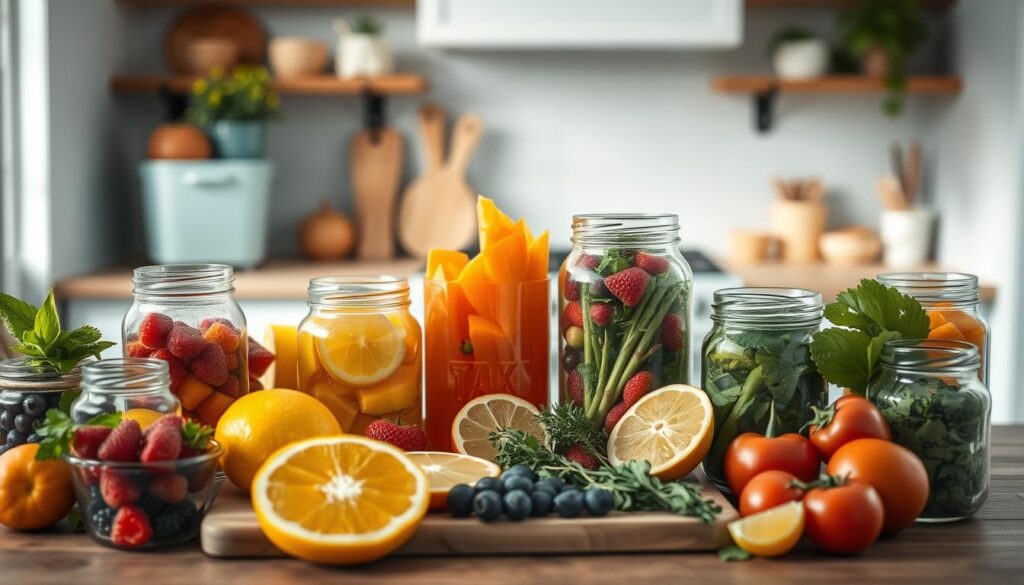
Lean into produce that thrives without refrigeration. Cherry tomatoes and snap peas hold up in lunch bags, while stone fruits add sweetness to grain bowls. One graphic designer I know keeps a desk drawer stocked with individual lime wedges and chili flakes: “A quick squeeze wakes up yesterday’s quinoa.”
Heartier sauces anchor warm-weather dishes. Try these combos:
| Dish | Key Ingredients | Sauce Pairing |
|---|---|---|
| Chilled soba noodles | Edamame, shredded carrots | Peanut-lime dressing |
| Grilled veggie wraps | Zucchini, bell peppers | Mint yogurt sauce |
| Herbed potato salad | Baby potatoes, dill | Lemon-chive aioli |
Summer’s bounty shines in no-cook prep. Marinate grilled chicken in mango salsa overnight, or toss roasted potatoes with pesto while they’re still warm. As seasons shift, swap peaches for roasted squash and basil for rosemary. A client shared her genius hack: “I freeze herb ice cubes in July—winter soups taste like sunshine.”
Remember: bold flavors travel well. Pack dressings in reusable tubes and layer ingredients strategically. Your midday break deserves that farmers’ market joy—no kitchen required.
Essential Ingredients for Versatile Meal Prep
Imagine transforming your lunchbox into a flavor playground with just three core components. The secret lies in choosing ingredients that multitask beautifully—items that pair well across multiple dishes while staying fresh for days.
Whole Grains and Fresh Greens
Start with sturdy bases that hold up without refrigeration. Cooked quinoa becomes tomorrow’s salad or today’s wrap filler. Try these combos:
- Farro + massaged kale (the olive oil softens leaves)
- Brown rice + shredded Brussels sprouts (stays crunchy)
- Bulgur wheat + spinach (wilts just enough by lunch)
One client stores pre-washed greens in mason jars with paper towels—they stay crisp all week. “My desk drawer has everything I need to build nourishing bowls,” she shared.
Flavors That Make a Difference
A great dressing turns basic ingredients into something special. Keep these elements on hand:
| Texture Booster | Flavor Hero | Nutrition Powerhouse |
|---|---|---|
| Toasted almonds | Lemon zest | Mashed avocado |
| Crispy onions | Chili crisp | Hemp seeds |
Avocado adds creaminess without mayo—smash it into dressings or layer slices in jars. A reader once told me: “I drizzle everything with tahini mixed with maple syrup. It makes even leftover grains taste decadent!”
Experiment with bold pairings. Roasted sweet potatoes love tangy yogurt sauce, while chickpeas thrive under lime-cilantro dressing. Your combinations are endless when you master these building blocks.
Strategies for Batch Cooking Without a Kitchen
Batch cooking in a studio apartment taught me more about efficiency than culinary school ever did. With just a microwave and two square feet of counter space, I learned to roast vegetables on a baking sheet balanced over the sink. The key? Treat every appliance as multi-functional.
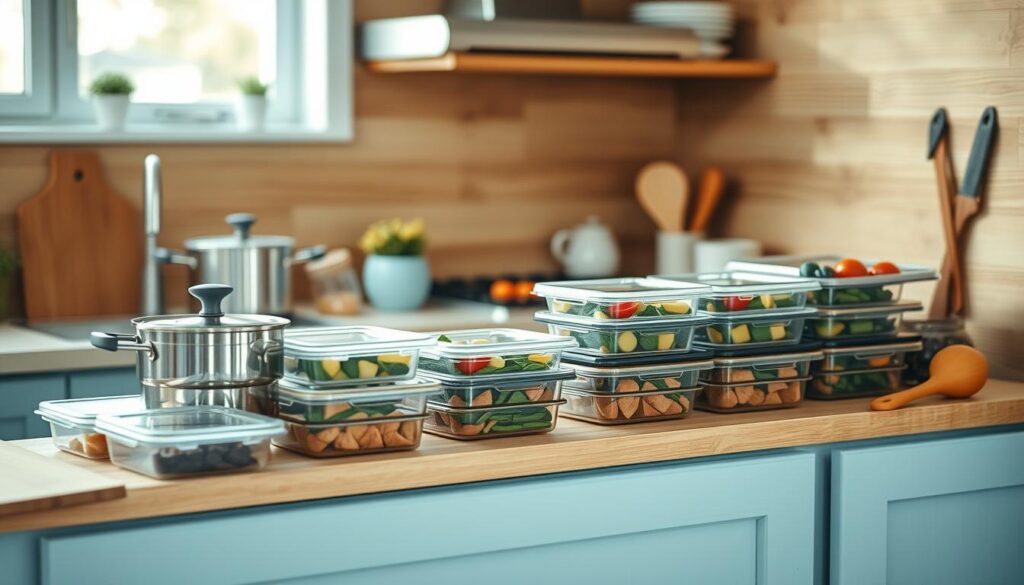
Microwave steaming works wonders for grains and proteins. Try this sequence:
- Cook quinoa in 5-minute intervals (stir between cycles)
- Steam frozen edamame pods while chopping veggies
- Reheat yesterday’s roasted chickpeas for crunch
Storage makes or breaks your system. Glass containers with dividers keep components fresh for three days. One project manager shared her hack: “I freeze cooked lentils in muffin tins—pop out portions as needed for clean eating prep.”
| Sheet Pan Use | Prep Day | Leftover Transformation |
|---|---|---|
| Roasted veggies | Sunday | Grain bowl base |
| Baked tofu | Wednesday | Wrap filling |
| Toasted nuts | Any day | Salad topping |
Leftovers become assets when planned. Double your roasted cauliflower—half becomes tomorrow’s salad, the other half blends into Thursday’s soup. A client once joked: “My office fridge has better organization than my home kitchen!”
Experiment with portable tools. A rice cooker can simmer oats while you shower, and a slow cooker plugged in your workspace makes office chili possible. Batch cooking isn’t about perfection—it’s about creating building blocks that adapt to your day.
Light and Nutritious Wraps and Sandwiches
Last Tuesday’s dash to catch the 7:45 AM train taught me the true value of a perfectly packed wrap. Portable lunches thrive on smart layering—think crisp veggies hugging tender proteins, all hugged by a sturdy tortilla or crusty roll. Let’s build midday fuel that survives commutes and desk drawers.
Building Better Desk-Friendly Sandwiches
Chickpea salad shines when mashed with avocado instead of mayo—creamy texture without sogginess. Add celery for crunch and lemon zest for brightness. For Caprese-inspired options, layer pesto between fresh mozzarella and tomato slices, keeping basil leaves separate until lunchtime.
| Component | Prep Tip | Storage Method |
|---|---|---|
| Chicken breast | Shred & season night before | Airtight container |
| Leafy greens | Layer between paper towels | Separate compartment |
| Dressing | Use lemon-tahini base | Small leak-proof jar |
Prevent soggy bread by toasting slices lightly or using cabbage leaves as wraps. One reader shared: “I pack tomato slices in a tiny container—add them right before eating. Game-changer!”
Pair sandwiches with sides that travel well:
- Roasted edamame pods (5 minutes in air fryer)
- Apple slices dipped in almond butter
- Marinated cucumber ribbons
Remember: quality dressings elevate simple ingredients. A drizzle of balsamic glaze transforms basic veggies into gourmet fare. As one client noted, “My coworkers now ask for my ‘fancy’ lunch recipes—it’s just strategic prep!”
Flavorful Dressings and Sauces to Elevate Your Meal
Last month, I rescued a bland grain bowl with a five-minute lemon-tahini blend that changed my lunch game forever. The right sauce turns basic ingredients into crave-worthy creations—no culinary degree required. Let’s unlock the magic of bold flavors that survive desk drawers and commute tumbles.
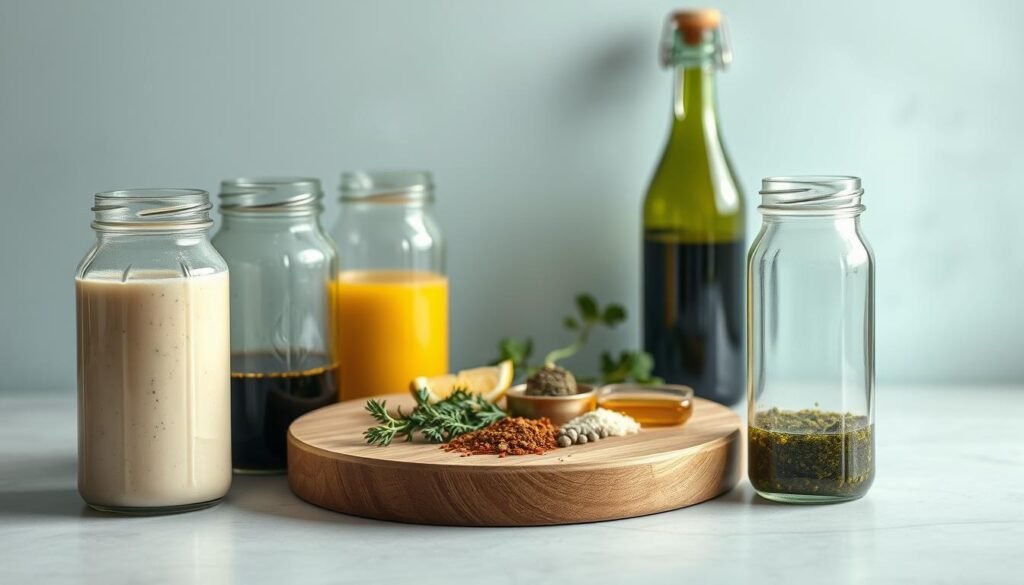
Mix-and-Match Magic
These three versatile recipes became office favorites through client testing:
- Zesty Green Goddess: Blend 1 avocado + ½ cup Greek yogurt + handful of basil + 1 garlic clove + 2 tbsp lemon juice
- Smoky Chipotle: Whisk 3 tbsp mayo + 1 minced chipotle pepper + 1 tsp honey + 1 tbsp lime juice
- Creamy Tahini: Mix ¼ cup tahini + 3 tbsp water + 1 tbsp maple syrup + ½ tsp cumin
Flavor Pairing Guide
| Sauce | Best With | Pro Tip |
|---|---|---|
| Green Goddess | Grilled chicken wraps | Add dill for fish dishes |
| Chipotle | Roasted sweet potatoes | Thin with broth for grain bowls |
| Tahini | Chickpea salads | Stir in za’atar for Mediterranean flair |
Adjust any recipe to your taste—more citrus for brightness, extra spices for depth. Store dressings in small jars for up to five days. One teacher shared: “I prep four sauce varieties Sunday night—my lunches feel gourmet all week!”
Freezer-Friendly Meal Prep Recipes
My freezer once saved me from ordering pizza three nights in a row during tax season. A stash of ready-to-heat flavor-packed dishes transforms chaotic evenings into manageable ones. These recipes aren’t just about convenience—they’re your secret weapon against food waste and midday hunger emergencies.
Batch-freezing works best with hearty ingredients. Soups thicken, casseroles meld flavors, and proteins stay tender. Try these tested favorites:
| Recipe | Prep Time | Storage Duration | Reheating Method |
|---|---|---|---|
| Spinach & mushroom baked ziti | 45 minutes | 3 months | Microwave + foil cover |
| Spiced black bean burgers | 30 minutes | 2 months | Toaster oven |
| Coconut chicken curry | 55 minutes | 4 months | Stovetop simmer |
Portion control prevents waste. Freeze individual servings in silicone muffin cups or deli containers. One teacher shared: “I label everything with ‘Eat by’ dates—no more mystery meals!”
For best results:
- Cool food completely before freezing
- Use parchment between layers for easy separation
- Leave ½ inch space in containers for expansion
Your future self will thank you when deadlines hit. As a nurse told me last week: “Coming home to homemade chili after a 12-hour shift? Total game-changer.”
Easy Soup and Stew Options for Work Lunches
Your desk becomes cozier with a thermos of simmered goodness. Hearty soups and stews shine in office settings—they reheat quickly, pack nutrients, and taste richer each day. The magic lies in building layers of flavor through smart techniques.
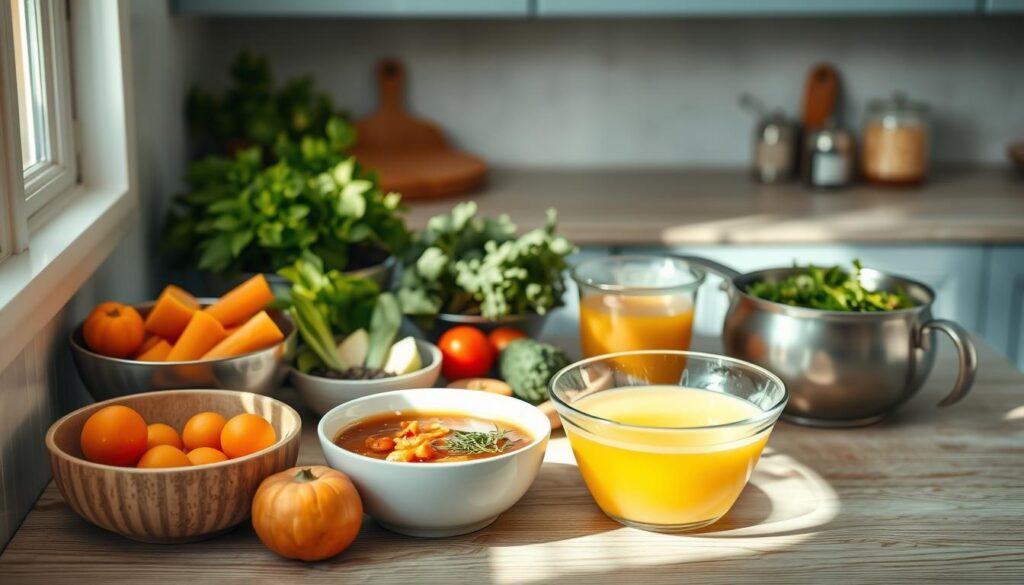
Simmering Techniques for Enhanced Flavors
Low-and-slow cooking transforms basic ingredients into complex dishes. Try these methods:
- Toast spices first to unlock earthy notes
- Simmer tomatoes for 20 minutes to deepen their sweetness
- Add broccoli stems early for savory undertones
Black bean chili improves overnight as cumin and smoked paprika meld. One reader noted: “My recipe tastes bolder on Thursday than Monday—leftovers become the main event!”
| Dish | Key Ingredients | Flavor Tip |
|---|---|---|
| Lentil stew | Black beans, tomatoes | Finish with lemon zest |
| Minestrone | Pasta, broccoli | Add fresh basil after reheating |
| Chicken tortilla | Black beans, tomatoes | Top with crispy tortilla strips |
Double batches save time while intensifying taste. Freeze portions in jars for grab-and-go lunches. Explore hearty soup recipes that travel well in thermoses.
Sturdy vegetables like kale hold texture for days. Pasta absorbs broth gradually—add it just before serving. A project manager shared her hack: “I pack toppings separately—avocado slices and pepitas stay fresh all week.”
Creative Utilization of Leftovers
Last winter, I turned Thursday’s roasted squash into Friday’s golden curry that vanished before noon. Leftovers aren’t sad repeats—they’re flavor opportunities waiting for reinvention. With smart strategies, last night’s components become tomorrow’s star attraction.
Store components separately to maximize flexibility. Keep proteins plain, grains unseasoned, and veggies roasted without sauce. This “building block” method lets you pivot flavors daily. A client shared: “I freeze cooked chicken in three portions—one becomes tacos, another joins pasta, the last tops salads.”
| Original Dish | Transformation | Key Additions |
|---|---|---|
| Herb-roasted chicken | BBQ chicken flatbread | Red onion, cilantro, lime |
| Plain brown rice | Kimchi fried rice | Fried egg, sesame seeds |
| Steamed broccoli | Broccoli frittata | Feta, sun-dried tomatoes |
Sunday nights are ideal for ingredient triage. Assess your fridge like a puzzle—what needs using first? Blend wilting spinach into pesto, or mix roasted root veggies with chickpeas for grain bowls. One parent told me: “Thursday’s sweet potato mash becomes Friday’s pancake batter with cinnamon and oat flour.”
“I keep ‘flavor boosters’ like pickled ginger and chili oil at my desk. Yesterday’s bland rice becomes today’s lunch masterpiece!”
Embrace the mashup mentality. Toss roasted veggies with canned white beans and vinaigrette for instant salad. Blend overripe bananas into oatmeal jars. Your creativity reduces waste while keeping midday breaks exciting—no kitchen required.
Organizing and Storing Your Prepped Meals
Discovering three identical glass containers at the back of my fridge taught me more about food storage than any cookbook. Strategic organization turns chaotic meal systems into smooth operations—especially when space and resources are limited.
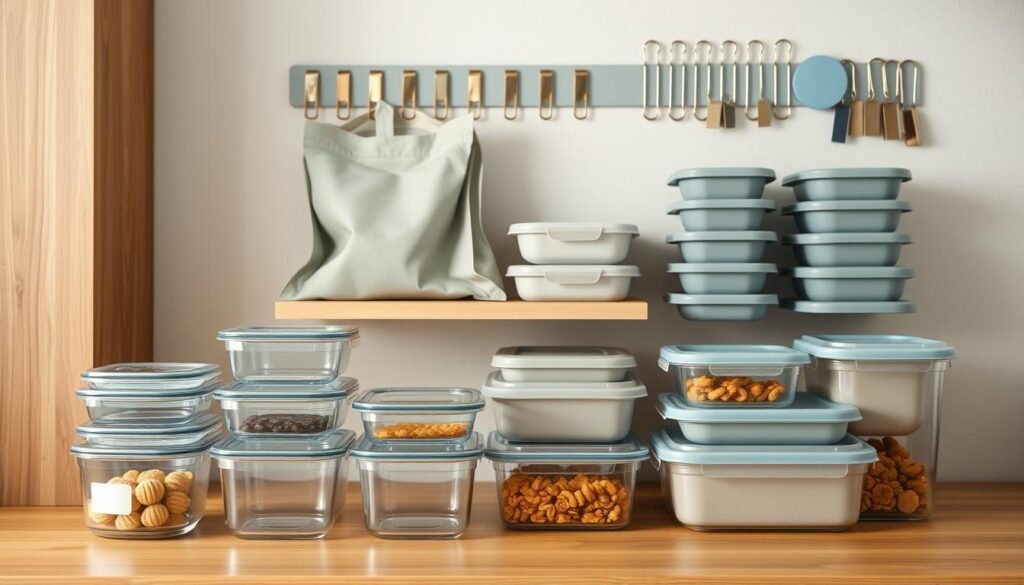
Smart Containers for Real Life
Choose tools that work harder than you do:
- Modular bento boxes: Separate wet/dry ingredients until assembly
- Leak-proof jars: Ideal for layered salads or overnight oats
- Freezer-safe silicone bags: Flat storage saves space
Glass containers with snap lids prevent flavor transfer and withstand office microwaves. A project manager shared her system: “Color-coded lids help my family grab the right lunch quickly—blue for salads, green for wraps.”
| Storage Need | Best Container | Pro Tip |
|---|---|---|
| Crunchy veggies | Jar with paper towel | Change towel daily |
| Sauces/dressings | 2 oz squeeze bottles | Label with masking tape |
| Frozen portions | Mason jars (leave headspace) | Write thaw dates on lids |
Label everything—even if you think you’ll remember. Use painter’s tape and sharpies for easy updates. Store similar items together: breakfasts on the left, lunches front-and-center. One teacher told me: “I dedicate a fridge shelf to each day—no more Monday morning scavenger hunts.”
“Stacking containers by size saved my sanity. Now I can see every option without rearranging the whole fridge.”
Remember: organization isn’t about perfection. It’s about creating systems that survive real-world chaos. When your containers work smarter, you reclaim precious morning minutes—and actually enjoy your midday fuel.
Balancing Health and Flavor in Workplace Meals
A dash of smoked paprika transformed my bland desk lunch into a flavor revelation. Nourishing midday fuel shouldn’t sacrifice taste for nutrition—or vice versa. The magic happens when crunchy textures meet smart seasoning, and portion sizes align with energy needs.
Portion Control and Nutritional Insights
Think of your container as a canvas. Fill half with roasted broccoli or shredded kale, one-quarter with grilled chicken, and the rest with wild rice. This visual formula ensures balanced macros without scales. One client shared: “Using 4-ounce deli containers for proteins keeps my lunches consistent—no guesswork!”
Flavor thrives in clever pairings:
- Massage lemon juice into kale to soften leaves and boost iron absorption
- Toss cherry tomatoes with balsamic glaze for natural sweetness
- Mix ground cumin into Greek yogurt for a protein-rich dip
| Component | Portion Guide | Flavor Boost |
|---|---|---|
| Grilled chicken | Deck of cards | Smoked paprika rub |
| Whole grains | Tennis ball | Toasted sesame seeds |
| Dressing | Ping pong ball | Whisked tahini + lime |
“I prep dressings in contact lens cases—just enough for flavor without drowning my greens.”
Sturdy ingredients maintain texture for days. Swap pasta with spiralized zucchini in Caprese salads, or use ground turkey in lettuce wraps. Small tweaks create big impact: a sprinkle of chili flakes wakes up steamed veggies, while fresh herbs add restaurant-worthy flair.
Last month, a client showed me her “desk drawer pantry” stocked with spice blends and olive oil packets—proof that smart systems trump fancy tools. Whether you’re juggling shared microwaves or limited fridge space, nourishing midday fuel comes down to flexibility over perfection.
Batch cooking Sundays and strategic storage solve most challenges. Glass containers keep grains fresh, while freezer-friendly recipes save precious weekday minutes. Rotate three core ingredient combinations weekly to keep things exciting without extra effort.
Your best recipe? Experimentation. Swap dressings, try new veggie pairings, or repurpose leftovers into wraps. Share your wins (and fails!) with our community—every office warrior brings fresh ideas to the table.
Remember: small efforts compound. A ten-minute prep tonight means relaxed mornings and satisfying lunches all week. Your desk just became the most delicious spot in the building.
Savory Quinoa Nori Snack Rolls
These Savory Quinoa Nori Snack Rolls are a delightful fusion of nutty quinoa and fresh vegetables, wrapped in crisp nori sheets. Perfect for a light lunch or a healthy snack, they're both nutritious and satisfying.
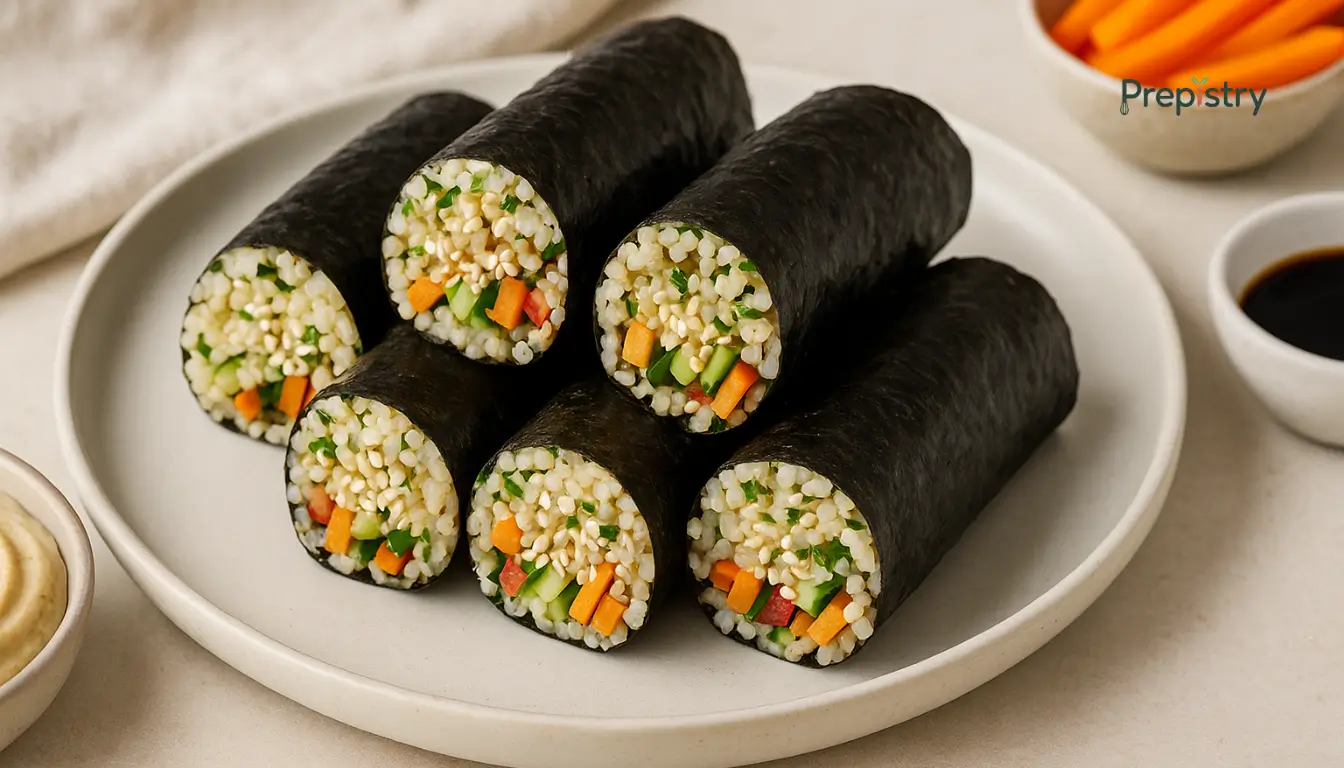
Nutrition Information
Equipment Needed
- Sushi rolling mat
- Sharp knife
- Cutting board
- Medium saucepan
- Mixing bowl
Ingredients
-
1 cup quinoa, rinsed
-
2 cups water
-
1 tablespoon rice vinegar
-
1 teaspoon sesame oil
-
4 nori sheets
-
1/2 avocado, sliced
-
1/2 cucumber, julienned
-
1 small carrot, julienned
-
1/4 red bell pepper, julienned
-
2 tablespoons hummus
-
Soy sauce for dipping
Instructions
Recipe Video
Savory Quinoa Nori Snack Rolls Recipe
Learn how to make delicious and healthy Savory Quinoa Nori Snack Rolls with this easy-to-follow recipe.

